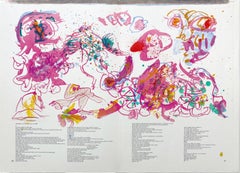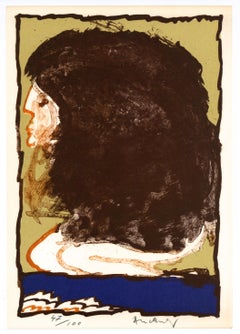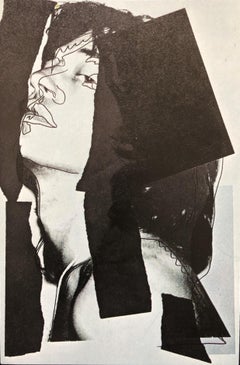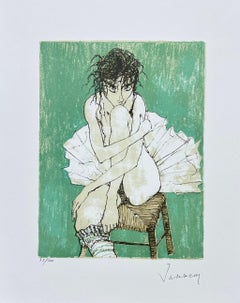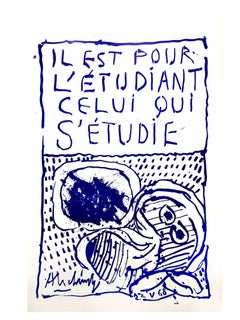Pierre Alechinsky Portrait Prints
Belgian, b. 1927
Pierre Alechinsky is a belgian painter born in 1927 in Brussels.
Attracted by painting, Pierre Alechinsky begins aged 17 in the Ecole Nationale Supérieure d'Architecture et des Arts Décoratifs de la Cambre in Brussels. He was involved in the Cobra artistic movement with Karel Appel and Asger Jorn and organised exhibitions. In the early fifties, he learnt the art of engraving with Stanley William Hayter and also Japanese calligraphy. He met Giacometti, Bram Van Velde, and Victor Brauner.
In 1955, he signs for his first exhibition at the Palais des Beaux-Arts de Bruxelles, then at the Institute of Contemporary Arts of London. His artworks, prints, lithographies, engravings and books illustrations can also be found in the USA, in France, in the Netherlands, Denmark and Germany.
On and after 1965, fascinated by the Oriental calligraphy, he uses acrylic painting, ink, different types of paper as bills, and gets carried away by action painting technique.
During the eighties, he became for four years a teacher of plastic arts at the Ecole Nationale Supérieure des Beaux Arts.
Also a writer, Pierre Alechinsky published many books including «Titres et pains perdus », « Baluchon et ricochets », and in 2004 «Des deux mains ».
He lives and works in France.to
1
1
1
Overall Width
to
Overall Height
to
1
43
267
171
118
87
2
1
1
1
1
1
1
1
2
2
Artist: Pierre Alechinsky
"Untitled": Lithograph from One Cent Life
By Pierre Alechinsky
Located in Austin, TX
Artist: Pierre Alechinsky
Title: "Untitled": Lithograph from One Cent Life
Year: 1964
Medium: 2 page lithograph, as printed from One Cent Life
As printed with Walasse Ting poem, fro...
Category
1960s Expressionist Pierre Alechinsky Portrait Prints
Materials
Lithograph
$225 Sale Price
50% Off
signed / numbered original lithograph
By Pierre Alechinsky
Located in Henderson, NV
Medium: original lithograph. Signed in pencil and numbered 47/100. Printed in Neuchatel, Switzerland in 1977 at the Imprimerie Paul Attinger. This signed and numbered lithograph was ...
Category
1970s Pierre Alechinsky Portrait Prints
Materials
Lithograph
Related Items
Mick Jagger X - Andy Warhol, Announcement card, Rolling Stones, Musician, Pop
By (after) Andy Warhol
Located in Knowle Lane, Cranleigh
Mick Jagger X - After Andy Warhol. This black and white colour scheme lithographic print features - Mick Jagger - an iconic rock legend who was the frontman and one of the founders ...
Category
1970s Pop Art Pierre Alechinsky Portrait Prints
Materials
Lithograph
$1,271
H 12.01 in W 8.67 in D 0.79 in
Ballerine sur fond vert, 1995, original lithograph by Jean Jansem, handsigned
By Jean Jansem
Located in Les Acacias GE, GE
Jean Jansem (1920-2013)
Ballerine sur fond vert, 1995
Lithographie sur papier Arches, justifiée et numérotée 48/100
Signée en bas à droite
22 x 17 cm / 32 x 26 cm
Bibliographie:
...
Category
Late 20th Century Expressionist Pierre Alechinsky Portrait Prints
Materials
Lithograph
$359 Sale Price
20% Off
H 12.6 in W 10.24 in
Mick Jagger III - Andy Warhol, Announcement card, Rolling Stones, Musician, Pop
By (after) Andy Warhol
Located in Knowle Lane, Cranleigh
Mick Jagger III - After Andy Warhol. In this print, Warhol incorporated solid abstract shapes to emphasize Jagger's features - here, focusing on the singer’s famous lips, along with...
Category
1970s Pop Art Pierre Alechinsky Portrait Prints
Materials
Lithograph
$1,271
H 12.01 in W 8.67 in D 0.79 in
Mick Jagger VI - Andy Warhol, Announcement card, Rolling Stones, Musician, Pop
By (after) Andy Warhol
Located in Knowle Lane, Cranleigh
Mick Jagger VI - After Andy Warhol. The line drawing placed on a golden backdrop is a feature unique to this print adding a sense of motion to Jagger’s features which shows him in a...
Category
1970s Pop Art Pierre Alechinsky Portrait Prints
Materials
Lithograph
$1,272
H 12.01 in W 8.67 in D 0.79 in
Le Clairon, 1993, original lithograph by Jean Jansem, handsigned and numbered
By Jean Jansem
Located in Les Acacias GE, GE
Jean Jansem (1920-2013)
Le Clairon, 1993
Lithographie sur papier Arches, justifiée EA12/30
Signée en bas à droite
65 x 50 cm / 76 x 56 cm
Bibliographie:
CR Jansem, 2000, n°85
"Ma...
Category
Late 20th Century Expressionist Pierre Alechinsky Portrait Prints
Materials
Lithograph
$945
H 29.93 in W 21.26 in
Sophie aux bas rouges, 1993, original lithograph by Jean Jansem
By Jean Jansem
Located in Les Acacias GE, GE
Jean Jansem (1920-2013)
Sophie aux bas rouges, 1993
Lithographie sur papier Arches, justifiée E/A
Signée en bas à droite
66 x 50 cm / 76 x 56 cm
Bibliographie:
CR Jansem, 2000, n°...
Category
Late 20th Century Expressionist Pierre Alechinsky Portrait Prints
Materials
Lithograph
$1,300
H 29.93 in W 22.05 in
Sylvie, fond rouge, 1995, original lithograph by Jean Jansem, handsigned
By Jean Jansem
Located in Les Acacias GE, GE
Jean Jansem (1920-2013)
Sylvie, fond rouge, 1995
Lithographie sur papier Arches
Signée en bas à droite et justifiée en bas à gauche
64,5 x 50 cm / 76 x 56 cm
Bibliographie:
Impri...
Category
Late 20th Century Expressionist Pierre Alechinsky Portrait Prints
Materials
Lithograph
$756 Sale Price
20% Off
H 29.93 in W 21.26 in
Petite danseuse aux cheveux défaits, 1991, original lithograph by Jean Jansem
By Jean Jansem
Located in Les Acacias GE, GE
Jean Jansem (1920-2013)
Petite danseuse aux cheveux défaits, 1991
Lithographie sur papier Arches
Signée en bas à droite et justifiée en bas à droite
66 x 47 cm / 76 x 54 cm
Imprime...
Category
Late 20th Century Expressionist Pierre Alechinsky Portrait Prints
Materials
Lithograph
$1,241
H 29.93 in W 21.26 in
Joelle de dos au coussin vert 1995 original lithograph by Jean Jansem handsigned
By Jean Jansem
Located in Les Acacias GE, GE
Jean Jansem (1920-2013)
Joelle de dos au coussin vert, 1995
Lithographie sur papier Arches
Signée et justifiée
56 x 76 cm
Album: La danse, 1999
Imprimeur: Arts-Litho, Paris
Editeur ...
Category
Late 20th Century Expressionist Pierre Alechinsky Portrait Prints
Materials
Lithograph
$755 Sale Price
20% Off
H 22.05 in W 29.93 in
Le coffre et la lanterne, 1986, original lithograph by Jean Jansem, handsigned
By Jean Jansem
Located in Les Acacias GE, GE
Jean Jansem (1920-2013)
Le coffre et la lanterne, 1986
Lithographie sur papier Arches
Signée en bas à droite et justifiée en bas à gauche
67 x 51 cm / 76 x 54 cm
D'une édition à 30...
Category
Late 20th Century Expressionist Pierre Alechinsky Portrait Prints
Materials
Lithograph
$756 Sale Price
20% Off
H 29.93 in W 21.26 in
La Brocante, 1975, original lithograph by Jean Jansem, handsigned and numbered
By Jean Jansem
Located in Les Acacias GE, GE
Jean Jansem (1920-2013)
La Brocante, 1975
Lithographie sur papier Arches
Signée en bas à droite et justifiée en bas à gauche
69 x 51,5 cm / 76 x 54,5 cm
Bibliographie:
Jansem Lith...
Category
Late 20th Century Expressionist Pierre Alechinsky Portrait Prints
Materials
Lithograph
$803 Sale Price
20% Off
H 29.93 in W 21.46 in
La balance romaine, 1986, original lithograph by Jean Jansem, handsigned
By Jean Jansem
Located in Les Acacias GE, GE
Jean Jansem (1920-2013)
La balance romaine, 1986
Lithographie sur papier Japon
Signée en bas à droite et justifiée Hors Commerce
50 x 65 cm / 54 x 76 cm
Très rare exemplaire
D'un...
Category
Late 20th Century Expressionist Pierre Alechinsky Portrait Prints
Materials
Lithograph
$1,134 Sale Price
20% Off
H 21.26 in W 29.93 in
Previously Available Items
Pierre Alechinsky, - Mai 68 Original French Poster - Mai 68
By Pierre Alechinsky
Located in Collonge Bellerive, Geneve, CH
Pierre Alechinsky - Mai 68 Original French Poster - Mai 68
Tchou Editions, Paris, printed in 1968.
Dimensions: 48 x 32.5 cm
Paris, May 1968: The revolution that never was
Even without retrieving that bundle of yellowing French newspapers from the top shelf in a closet, it is easy to remember the night of May 10, 1968, in Paris. It is far less easy, 40 years later, to discern what it was all about. Adolescent hormones, the death of communism, the death of capitalism or, as André Malraux suggested at the time, the death of God?
Malraux, the writer and politician and the French culture minister at the time, may have been alone in invoking God's death as an explanation, but no one doubted that May 10 provoked an entire society to a rare assessment - call it an examination of conscience, if you will - of its fundamental values.
A week earlier, the police had been called in to occupy the Sorbonne, and Paris began to witness daily student marches, usually culminating in skirmishes between students throwing stones and the police firing tear gas.
By May 10, the number of student demonstrators was estimated at 20,000. At every street leading to the Sorbonne, they found their way blocked by vans and ranks of riot police. This time, the students did not disperse. As darkness fell, they began prying up cobblestones, ransacking building sites and turning over parked cars to construct their own barricades facing the police ones.
For hours, the silent inner ring of police barricades stretching around much of the Latin Quarter stood surrounded by a noisy outer ring of student barricades. At 2:15 a.m., the police got the order to assault the student barricades. As the interior minister said, "The streets have to be clear for traffic."
Continue reading the main story
It took three hours of brutal fighting to do that: clouds of tear gas, Molotov cocktails, exploding automobile gas tanks, cobblestones hurled at the police, students chased down and beaten, more than 300 people injured but fortunately no gunfire - and no deaths.
When the radio reported a fire on Rue Gay-Lussac that fire trucks could not reach because of the street fighting and barricades, two young Americans living nearby began deciding what to take with them in case of urban conflagration: 1) the 2-year-old daughter; 2) passports and money; 3) the notes for the dissertation. After that, it didn't matter.
France woke up shocked. So, presumably, did President Charles de Gaulle, who had gone to bed early. Events accelerated. The left mounted a huge march of solidarity with the students, who reoccupied the Sorbonne. Workers began occupying their factories. Within another week, France was closed down by the general strike that revolutionaries had always dreamed of.
The story, of course, did not end in revolution, for which few people over 30 really had any stomach anyway. On May 30, de Gaulle put his foot down.
He addressed the nation briefly on the radio. He announced new elections and hinted at using military means to restore order. A deftly prepared demonstration immediately flooded the Champs-Élysées with hundreds of thousands of citizens previously maintaining a low profile.
Newsletter Sign UpContinue reading the main story
The Interpreter Newsletter
Understand the world with sharp insight and commentary on the major news stories of the week.
You agree to receive occasional updates and special offers for The New York Times's products and services.
May passed into June. Workers and students won some changes. The elections swept de Gaulle and his supporters back into power. Was it all merely a spring rainstorm? Hardly. For two astonishing weeks in May, an entire nation had been caught up in a frenzy of self-examination. Committees were formed to restructure secondary schooling, the university, the film industry, the theater, the news media. Everyone was a talking head.
What the talking heads were talking about were ideas spawned by a crazy array of leftist groups: revisionist socialists, Trotskyists, Maoists, anarchists, surrealists and Marxists. They were anticommunist as much as anticapitalist. Some appeared anti-industrial, anti-institutional, even anti-rational.
Three positive objectives and one great fear dominated their views. The objectives were self-management by workers, a decentralization of economic and political power and participatory democracy at the grass roots. The great fear was that contemporary capitalism was capable of absorbing any and all critical ideas or movements and bending them to its own advantage. Hence, the need for provocative shock tactics. "Be realistic: Demand the impossible!" was one of the May movement's slogans.
To many critics, all this was only the final twitch of a quasi-religious socialist utopianism that had long inspired workers and intellectuals rebelling against the pains of industrialization.
Other critics preferred psychological explanations: May 1968 was a Freudian fling of adolescent revolt against Mom and Dad. Or it was a nostalgic bout of playacting, a childish re-enactment of the storming of the Bastille and other Greatest Hits of France's Revolutions. Or it was, paradoxically, an unwitting reinforcement of the individualist consumer capitalism that it claimed to oppose.
On the other side, the anti-authoritarian spirit of 1968 was eventually seen as a wellspring of the successful rebellion against Soviet-bloc communism in 1989. The link was made graphically by book jackets rotating 68 to read 89. After all, Prague Spring...
Category
1960s Pierre Alechinsky Portrait Prints
H 18.9 in W 12.8 in D 0.04 in
Pierre Alechinsky portrait prints for sale on 1stDibs.
Find a wide variety of authentic Pierre Alechinsky portrait prints available for sale on 1stDibs. You can also browse by medium to find art by Pierre Alechinsky in lithograph and more. Much of the original work by this artist or collective was created during the 20th century and is mostly associated with the Expressionist style. Not every interior allows for large Pierre Alechinsky portrait prints, so small editions measuring 9 inches across are available. Customers who are interested in this artist might also find the work of Jean Jansem, George Grosz, and Nicola Simbari. Pierre Alechinsky portrait prints prices can differ depending upon medium, time period and other attributes. On 1stDibs, the price for these items starts at $225 and tops out at $800, while the average work can sell for $513.
